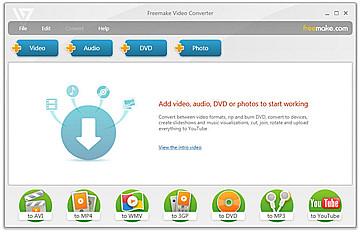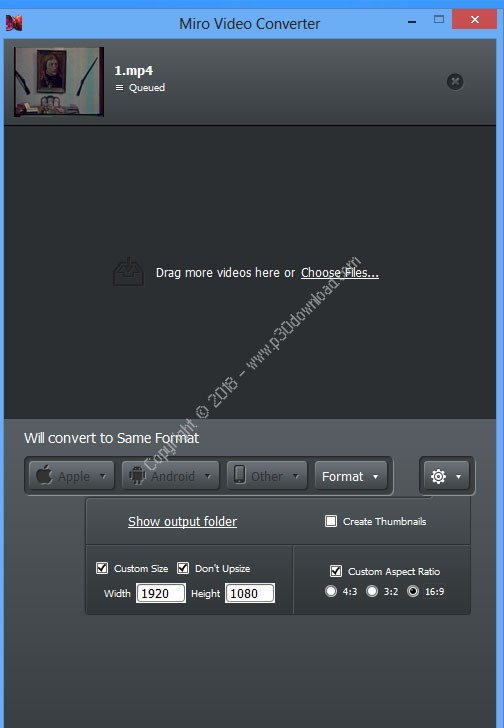
- #Miro video converter audio setting mp4
- #Miro video converter audio setting pro
- #Miro video converter audio setting professional
- #Miro video converter audio setting download
#Miro video converter audio setting mp4
Import MP4 recorded from various camcorders like Samsung HMX-H100 camcorder, Sanyo XACTO HD1000 Full HD camera, Flip camcorder, JVC GY-HM100, JVC GY-HM700 and more to FCP or FCE
#Miro video converter audio setting pro
Import AVI video to Final Cut Pro X, Final Cut Pro 7, Final Cut Pro or Final Cut Express And it even features advanced editing functions like trim, crop, effect, rotate, add or remove subtitle, adjust video audio volume/size/bitrate/channel and etc.īigasoft Total Video Converter is just the ideal MP4 to Final Cut Pro Converter! It can easily convert all kinds of MP4 videos whatever recorded from cameras/camcorders or downloaded from website like YouTube, or from other sources to FCP, FCP X, FCE supported Apple ProRes or DV.
#Miro video converter audio setting download
And it even supports converting Adobe audio to other audio format.įurthermore, this ideal Adobe File Converter also helps to download media files from video/audio sharing website like YouTube, BBC and etc. Besides converting video to Adobe Premiere, iDealshare VideoGo also helps to convert Adobe Premiere produced video to other popular video format.Īcting as the Adobe Audio Converter, iDealshare VideoGo can easily convert all popular audio formats like FLAC, OGG, WAV, M4A, APE, DTS, AC3, AU, RA, M4B, WAV, VOC, QCP, CAF, SHN, AIFF, MPC, PCM and etc to Adobe app like Adobe Audition compatible audio format. It also helps to convert Adobe created media files to other video or audio formats.Īcting as the Adobe Video Converter, it supports converting almost all Adobe unsupported video format like VOB, MKV, MOD, TOD, WTV, SWF, MVI, AVCHD, MTS, M2T, M2TS, DivX, Xvid, DVR, MP4, WMV, MOV, M4V, RMVB, OGV, OGM, WebM, Apple ProRes and etc to Adobe Premiere supported video or audio formats.
#Miro video converter audio setting professional
IDealshare VideoGo, the professional Adobe Media Converter can fast and batch convert all kinds of video and audio files to Adobe Products like Adobe Premiere supported format. This opens the Export Settings dialog where you can tweak a variety of video settings (see below). For more control over the encoding, right-click the source file name and choose Export Settings.

Click the Start Queue button to create a new, usually smaller, video file.Some outputs have more than one aspect ratio or data rate setting for the same device, so try out different settings to see which produces the best result at the lowest file size. You might keep the ratio of the video source file to avoid a “letterbox”effect (black bars on the sides of the frame). If you’re not showing a video fullscreen, you may choose a video aspect ratio that’s different from the device’s aspect ratio. Click the Preset menu to select a preset that best represents your target output for example, the Apple iPad. Choose the video format you’re aiming for from the Format menu-in this example, H.264.Or, even easier, just drag the file into the large central area. In the top Queue section, click the + button to add the file you want to encode (for example, a legacy QuickTime file). That is the Adobe Media Encoder, which comes with the Adobe Creative Suite Design Premium, Web Premium, and Production Premium. So it comes as a pleasant surprise to find that most of us already have the utility we need to convert video, and which provides easy presets for common output like an iPad or an iPhone. This is the amount of information, or detail, that is stored per unit of time in a video. You need to choose an appropriate data rate. For example, you have to be concerned with choosing the right aspect ratio (usually either 4:3 for standard television and 16:9 for widescreen and high-definition). Working with video introduces a lot of new terminology unfamiliar to those of us who have worked mostly in print and web publishing.

For most digital publishing projects-especially those targeted at mobile devices-it’s crucial to keep video clips to a reasonably small file size.

Video file sizes are far larger than audio, But, in addition to converting a file to the correct format, you will also need to create a video of the proper size. In a previous posting, I wrote about the video format to use for digital publishing-H.264-encoded video files. InDesign has had the ability to place video files since CS2, but its video capabilities were greatly enhanced in InDesign CS5 and 5.5. These days more of us are using InDesign to create non-print projects-interactive PDF, SWF, EPUB, and applications for tablets.


 0 kommentar(er)
0 kommentar(er)
